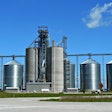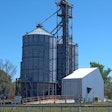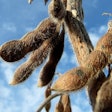The lesser grain borer,Rhizopertha dominica, is one of the most common and damaging insect pests of stored wheat in the United States. In the autumn, the periphery of the grain bulk cools faster than the center and this allows grain insects to continue to reproduce in the center. Very little is known about the movement of the lesser grain borer in temperature gradients in stored grain. The Stored Product Insect Research Unit (SPIRU) of the Center for Grain and Animal Health Research (CGAHR) studied the movement and temperature preference of the lesser grain borerin a 22-inch diameter cylinder with 3-inch high sides containing 44 pounds of wheat. Two temperature gradients were tested over a 24-hour period.
Beetles preferred the moderate temperature region of the cylinder in a 40 C to 20 C gradient, but avoided the highest temperature region. In a 24 to 20°C gradient, beetles did not move very much during the 24-hour period. When a 96-hour duration was used for the 24 to 20°C gradient, there were more beetles in the warmest center region of the gradient compared to the cooler middle or outer regions. Compared to other stored grain beetles, such as the rusty grain beetle, the lesser grain borer appears to move more slowly through the grain into preferred temperature regions. It is possible that adultR. dominicamay suffer higher winter mortality in grain bins compared to the rusty grain beetle because the lesser grain borer is not able to move quickly enough into the warmer regions of the grain mass as the periphery of the grain cools during the fall and winter months. This could affect the beetle's ability to overwinter in stored grain.
For more information, contact: Dr. Paul Flinn (785) 776-2707,[email protected](Collaborator: Dr. David Hagstrum)





















